The Green Light: Environmentally Sensitive Options At Life’s End
March 16, 2022

Have you made your plans? Do you know what you want? While the concept of planning in advance has been promoted for years regarding end-of-life health care and decision-making, what may be new is that now there are an array of post-death options to consider as well. It’s not just a matter anymore of a good death: you now need to think about what constitutes a good after death, especially regarding the disposal of your body (something that will likely be left to your loved ones to carry out.)
For years now, and especially in the wake of the pandemic, rituals around death, funerals, and burial have been evolving. By 2025, it’s expected that about 63% of North American deaths will be followed by cremation rather than burial– that, in and of itself, is a change from previous decades. What’s perhaps even more startling is the e-commerce business that’s growing to meet this cremation demand (which allows you to go online and make cremation arrangements for far-off relatives, often at a discounted rate), along with a new questioning of the techniques used in the cremation process. According to experts, cremation using fire produces a tremendous amount of carbon dioxide, while other methods can reduce these emissions by up to 90%. In particular, when Desmond Tutu of South Africa passed away at the end of 2021, his death caused quite a stir because he requested the use of “aquamation” rather than traditional cremation to dispose of his body. Aquamation is the process of using water, heat, and alkali chemicals to decompose the body rather than flames. In fact, aquamation is reputed to have the lowest environmental impact of all burial options. Twenty states have approved this option, but changes to the funeral industry are slow in developing and often have to overcome reluctance to accept new practices.
Yet the push for more environmentally friendly burial and body disposal options is clearly underway. The concept of “green burials” and environmentally-conscious funereal practices is gaining momentum, as more of us become aware of and concerned about the climate crisis and as younger generations begin to take over the logistics for the deaths of their aging loved ones. So, for example, in her new book, Our Last Best Act: Planning for the End of Our Lives to Protect the People and Places We Love, author Mallory McDuff, an environmental educator, argues that environmentally conscious burials can both change our relationship with death and help the Earth as well. Currently, there are about 1.4 million acres of US land used for cemeteries, containing 4 million gallons of highly toxic embalming fluids. What the new green burial movement hopes to promote are practices and rituals that in many ways correspond to existing Jewish and Muslim rituals: simple, biodegradable containers and simple clothing or shrouds, for example. There are also emerging conservation cemeteries, where burial does not involve a concrete vault, and where practices promote body decompensation in shallow graves, without toxic embalming fluids- even to the point in some instances where nutrient-rich soil becomes available as the end product. To read more about conservation cemeteries and other environmentally-connected burial options click here, or listen here to a recent public radio program on choosing eco-friendly options for your post-death arrangements.
Finally, for those who are squeamish about these sorts of conversations, or worried about the implications for their religious affiliations, there are arguments to be made that “natural” burial, even going so far as handling the washing and the burying of the body at home, are consistent with Christian (along with environmental) values. For a fascinating history of burial practices and the movement back to home-based arrangements in the US, read here.







